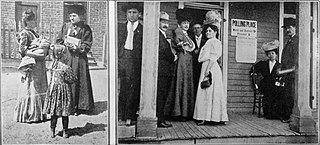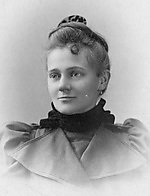
The Nineteenth Amendment to the United States Constitution prohibits the United States and its states from denying the right to vote to citizens of the United States on the basis of sex, in effect recognizing the right of women to vote. The amendment was the culmination of a decades-long movement for women's suffrage in the United States, at both the state and national levels, and was part of the worldwide movement towards women's suffrage and part of the wider women's rights movement. The first women's suffrage amendment was introduced in Congress in 1878. However, a suffrage amendment did not pass the House of Representatives until May 21, 1919, which was quickly followed by the Senate, on June 4, 1919. It was then submitted to the states for ratification, achieving the requisite 36 ratifications to secure adoption, and thereby go into effect, on August 18, 1920. The Nineteenth Amendment's adoption was certified on August 26, 1920.

The Colorado General Assembly is the state legislature of the State of Colorado. It is a bicameral legislature consisting of the Senate and House of Representatives that was created by the 1876 state constitution. Its statutes are codified in the Colorado Revised Statutes (C.R.S.). The session laws are published in the Session Laws of Colorado.

The Florida Legislature is the legislature of the U.S. state of Florida. It is organized as a bicameral body composed of an upper chamber, the Senate, and a lower chamber, the House of Representatives. Article III, Section 1 of the Florida Constitution, adopted in 1968, defines the role of the legislature and how it is to be constituted. The legislature is composed of 160 state legislators. The primary purpose of the legislature is to enact new laws and amend or repeal existing laws. It meets in the Florida State Capitol building in Tallahassee.

The Colorado House of Representatives is the lower house of the Colorado General Assembly, the state legislature of the U.S. state of Colorado. The House is composed of 65 members from an equal number of constituent districts, with each district having 75,000 people. Representatives are elected to two-year terms, and are limited to four consecutive terms in office, but can run again after a four-year respite.

The Michigan Senate is the upper house of the Michigan Legislature. Along with the Michigan House of Representatives, it composes the state legislature, which has powers, roles and duties defined by Article IV of the Michigan Constitution, adopted in 1963. The primary purpose of the Legislature is to enact new laws and amend or repeal existing laws.

The Arizona State Legislature is the state legislature of the U.S. state of Arizona. It is a bicameral legislature that consists of a lower house, the House of Representatives, and an upper house, the Senate. Composed of 90 legislators, the state legislature meets in the Capitol Complex in the state capital of Phoenix. Created by the Arizona Constitution upon statehood in 1912, the Arizona State Legislature met biennially until 1950. Today, they meet annually.

The Kentucky General Assembly, also called the Kentucky Legislature, is the state legislature of the U.S. state of Kentucky. It comprises the Kentucky Senate and the Kentucky House of Representatives.

The Oklahoma House of Representatives is the lower house of the legislature of the U.S. state of Oklahoma. Its members introduce and vote on bills and resolutions, provide legislative oversight for state agencies, and help to craft the state's budget. The upper house of the Oklahoma Legislature is the Oklahoma Senate.

Judy Eason McIntyre is an American politician from the U.S. state of Oklahoma. A Democrat, McIntyre served as an Oklahoma state Senator from 2004 to 2012 representing District 11, which includes Osage and Tulsa counties. She also served as State Representative from 2002 to 2004 representing District 73 where she was the first freshman appointed to the Speaker's Leadership Team. For the 16 years before her election to the Oklahoma Legislature, she was an elected board member for the Tulsa Public Schools in Tulsa, Oklahoma.

William J. Seitz III is the state representative for the 30th district of the Ohio House of Representatives. He is a Republican. The district consists of Cheviot, Delhi Township, Green as well as portions of Cincinnati, in Hamilton County. Formerly, Seitz represented the same seat from 2001 to 2007. He served in the Ohio Senate from 2007 to 2016. He has also served as Majority Leader since 2017 serving under five different speakers and two interim speakers. After 24 years in the Ohio General Assembly, Seitz has decided to retire at the end of his term in 2024.

The 2012 Project is a nonpartisan national campaign of the Center for American Women and Politics (CAWP) at Rutgers University. The project's goal is to identify and engage accomplished women to run for the United States Congress and state legislatures following reapportionment and redistricting within each state. U.S. Census data collected every 10 years include information on population shifts across the nation and are used to redraw congressional and state legislative districts resulting in new and open legislative seats. This work is done in order to comply with the 1965 Voting Rights Act and the "one person, one vote" principle. As of the 2010 Census, women made up 50.8% of the population. In terms of congressional and legislative seats, women currently make up 17% of the U.S. Senate and 16.8% of the U.S. House of Representatives. They make up a slightly larger percentage of the state legislatures at 23.6%. The aim of The 2012 Project is to increase the number of women running for state legislative and congressional office in 2012.

On November 7, 1893, a referendum on women's suffrage was held in Colorado that secured women's voting rights. Subsequently, Colorado became the first American state to enact women's suffrage by popular referendum. The act granted women the right to vote "in the same manner in all respects as male persons are."

Clara Cressingham was one of the first women elected to serve in any state legislature in the United States. She was also the first woman to serve in a leadership position in any state legislature.
The Center for American Women and Politics (CAWP) is a unit of the Eagleton Institute of Politics at Rutgers, The State University of New Jersey. Established in 1971, it is nationally and internationally recognized as the leading source of scholarly research and current data about U.S. women's political participation. Its mission is "to promote greater knowledge and understanding about women's participation in politics and government and to enhance women's influence and leadership in public life."
Gloria Travis Tanner was a politician and public figure in Colorado. A Democrat, she served in the Colorado House of Representatives from 1985-1994. In 1994, she became the first African American woman to serve as a Colorado state senator. In 2000, she founded a leadership and training institute for black women in Colorado. She was inducted into the Colorado Women's Hall of Fame in 2002.

Alma V. Short Lafferty was an American suffragist, clubwoman, and politician. She served two terms in the Colorado House of Representatives, from 1908 to 1912.

The 100th Massachusetts General Court, consisting of the Massachusetts Senate and the Massachusetts House of Representatives, met in 1879 during the governorship of Thomas Talbot. John B. D. Cogswell served as president of the Senate and Levi C. Wade served as speaker of the House.

The 116th Massachusetts General Court, consisting of the Massachusetts Senate and the Massachusetts House of Representatives, met in 1895 during the governorship of Frederic T. Greenhalge. William M. Butler served as president of the Senate and George von Lengerke Meyer served as speaker of the House.

Alice Pattison Merritt was an American politician who was the first woman to be elected to the Connecticut State Senate, in 1924. Reelected in 1926, she served in the senate from 1925 to 1929.
Alice Ruble was a state legislator in Colorado. She served in the Colorado House of Representatives. She nominated Henry M. Teller for U.S. Senator in support of his re-election. She served in Colorado's 14th General Assembly

















